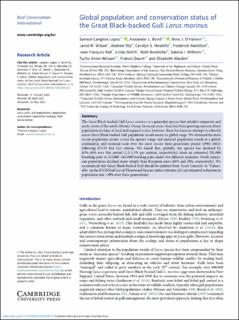| dc.contributor.author | Langlois Lopez, Samuel | |
| dc.contributor.author | Bond, Alexander L. | |
| dc.contributor.author | O'Hanlon, Nina J. | |
| dc.contributor.author | Wilson, Jared M. | |
| dc.contributor.author | Vitz, Andrew | |
| dc.contributor.author | Mostello, Carolyn S. | |
| dc.contributor.author | Hamilton, Frederick | |
| dc.contributor.author | Rail, Jean-Francois | |
| dc.contributor.author | Welch, Linda | |
| dc.contributor.author | Boettcher, Ruth | |
| dc.contributor.author | Wilhelm, Sabina I. | |
| dc.contributor.author | Anker-Nilssen, Tycho | |
| dc.contributor.author | Daunt, Francis | |
| dc.contributor.author | Masden, Elizabeth | |
| dc.coverage.spatial | north Atlantic Ocean | en_US |
| dc.date.accessioned | 2022-09-05T11:35:12Z | |
| dc.date.available | 2022-09-05T11:35:12Z | |
| dc.date.created | 2022-08-31T14:29:05Z | |
| dc.date.issued | 2022 | |
| dc.identifier.citation | Bird conservation international. 2022, 1-11. | en_US |
| dc.identifier.issn | 0959-2709 | |
| dc.identifier.uri | https://hdl.handle.net/11250/3015775 | |
| dc.description.abstract | The Great Black-backed Gull Larus marinus is a generalist species that inhabits temperate and arctic coasts of the north Atlantic Ocean. In recent years, there has been growing concern about population declines at local and regional scales; however, there has been no attempt to robustly assess Great Black-backed Gull population trends across its global range. We obtained the most recent population counts across the species’ range and analysed population trends at a global, continental, and national scale over the most recent three-generation period (1985–2021) following IUCN Red List criteria. We found that, globally, the species has declined by 43%–48% over this period (1.2–1.3% per annum, respectively), from an estimated 291,000 breeding pairs to 152,000–165,000 breeding pairs under two different scenarios. North American populations declined more steeply than European ones (68% and 28%, respectively). We recommend that Great Black-backed Gull should be uplisted from ‘Least Concern’ to ‘Vulnerable’ on the IUCN Red List of Threatened Species under criterion A2 (an estimated reduction in population size >30% over three generations). Larus gulls; gull populations; population assessment; population ecology; bird conservation | en_US |
| dc.language.iso | eng | en_US |
| dc.rights | Navngivelse 4.0 Internasjonal | * |
| dc.rights.uri | http://creativecommons.org/licenses/by/4.0/deed.no | * |
| dc.subject | Larus gulls | en_US |
| dc.subject | gull populations | en_US |
| dc.subject | population assessment | en_US |
| dc.subject | population ecology | en_US |
| dc.subject | bird conservation | en_US |
| dc.title | Global population and conservation status of the Great Black-backed Gull Larus marinus | en_US |
| dc.title.alternative | Global population and conservation status of the Great Black-backed Gull Larus marinus | en_US |
| dc.type | Peer reviewed | en_US |
| dc.type | Journal article | en_US |
| dc.description.version | publishedVersion | en_US |
| dc.rights.holder | © 2022 The Authors | en_US |
| dc.subject.nsi | VDP::Zoologiske og botaniske fag: 480 | en_US |
| dc.subject.nsi | VDP::Zoology and botany: 480 | en_US |
| dc.source.pagenumber | 1-11 | en_US |
| dc.source.journal | Bird conservation international | en_US |
| dc.identifier.doi | 10.1017/S0959270922000181 | |
| dc.identifier.cristin | 2047622 | |
| dc.relation.project | Andre: Scottish Government. | en_US |
| dc.relation.project | Andre: NERC Scottish Universities Partnership for environmental Res | en_US |
| dc.relation.project | Andre: University of the Highlands and Islands | en_US |
| cristin.ispublished | true | |
| cristin.fulltext | original | |
| cristin.qualitycode | 1 | |

